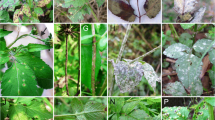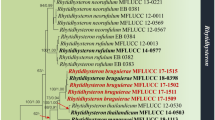Abstract
A sequel to the work of systematic surveying the mycobiota of Lantana camara aimed at finding potential biocontrol agents, was carried out during 1995–1996 covering part of its centre of origin in Brazil (state of Minas Gerais). Fifty-eight sampling sites, representing the four main climatic types in the state of Minas Gerais, were surveyed. Additional ad hoc collections were made in the states of Bahia, Espírito Santo, Paraná Rio de Janeiro and São Paulo. Fifteen fungal species were recorded in association with L. camara including the previously undescribed species Phomopsis lantanae-glutinosae sp. nov. Five fungi are also newly recorded on this host in Brazil: Cercospora lantanicola Corynespora cassiicola Meliola ambigua Mycovellosiella lantaniphila and Phomopsis lantanae. The following fungi, previously recorded on L. camara in Brazil, are recorded here for the first time in Minas Gerais: Dendryphielia aspera Micropustulomyces mucilaginosus Mycovellosiella lantanae Pseudocercospora guianensis and Puccinia lantanae.
Similar content being viewed by others
References
Cronk QCB, Fuller JL. Plant invaders: the threat to natural ecosystems. London: Chapman & Hall, 1995.
Holm LG, Herberger JP. The world's worst weeds. Proceedings of the Asian-Pacific Weed Control Interchange, 2nd. Madison: University of Wiscosin, 1969: 1-14.
Lorenzi H. Plantas daninhas do Brasil: terrestres, aquáticas, parasitas, tóxicas e medicinais. Nova Odessa: Editora Plantarum, 1991.
Greathead DJ. Biological control of Lantana-A review and discussion of recent developments in East Africa. PANS C 1968; 14: 167-175.
Stirton CH. Some thoughts on the poliploid complex Lantana camara L. Proceedings of the National Weed Conference, 2nd. Cape Town: University of Cape Town, 1977: 321-344.
Palmer WA, Pullen KR. The phytophagous arthropods associated with Lantana camara, L. hirsuta, L. urticifolia, and L. urticoides Verbenaceac in North America. Biological Control 1995; 5: 54-72.
Holm LG, Plucknett DL, Pancho JV, Herberger JP. The world's worst weeds: Distribution and biology. Honolulu: University Press of Hawaii, 1977.
Winder JA. Harley KLS. The phytophagous insects on Lantana in Brazil and their potential for biological control in Australia. Tropical Pest Management 1983; 29: 346-362.
Morton JF. Lantan or red sage (Lantana camara L., [Verbenaceae]), notorious weed and popular garden flower: some cases of poisoning in Florida. Economic Botany 1994; 48: 259-270.
Gentle CB, Duggin JA. Allelopathy as a competitive strategy in persistent thickets of Lantana camara L. in three Australian forest communities. Plant Ecology 1997; 32: 85-95.
Swenson U., Stuessy TF, Baeza M, Crawford DJ. New and historical plant introductions, and potential pests in the Juan Fernandez Islands, Chile. Pacific Science 1997; 51: 233-253.
Batianoff GN, Franks AJ. Environmental weed invasions on South-east Queensland foredunes. Proceedings of the Royal Society of Queensland 1998; 107: 15-34.
Singh RD, Brajinder Singh RKS, Tamang MB, Chakrabarty DN. Control of Lantana in non-cropped area and in tea plantation. International Journal of Pest Management 1997; 43: 145-147.
Thomas SF, Ellison CA. A century of classical biological control of Lantana camara: can pathogens make a significant difference? International Symposium of biological control of weeds, 10th, Abstracts, Montana, USA, 1999: 70.
Barreto RW. Studies on the pathogenic micoflora of selected weeds in the state of Rio de Janeiro (Brasil). [Ph. D. Thesis]. Reading: University of Reading, 1991. 588 pp.
Barreto RW, Evans HC, Ellison CA. The mycobiota of the weed Lantana camara in Brazil, with particular reference to biological control. Mycological Research 1995; 99: 769-782.
Antunes FZ. Caracterização climatica do estado de Minas Gerais. Informe Agropecuáno 1986; 12: 9-13.
Pereira JM. A micobiota fitopatogênica associada à planta invasora Lantana camara L. com ênfase no Estado de Minas Gerais-Brasil. [M. Sc. Dissertation]. Viçosa, Brazil, Universidade Federal de Viçosa, 1997. 72 pp.
Chupp C. A monograph of the fungus genus Cercospora. Ithaca: published by the author, 1954.
Deighton FC. Studies on Cercospora and allied genera. 5. Mycovellosiella Rangel and new species of Ramulariopsis. Mycological Papers 1974; 137: 1-75.
Kissmann KG, Groth D. Plantas infestantes e nocivas. São Paulo: BASF Brasileira, 1991.
Meenu, Kamal. New species of Corynespora. Mycological Research 1998, 102: 344-346.
Ellis MB. Dematiaceous Hyphomycetes. Kew: CMI, 1971.
Saccardo PA. Sylloge fungorurn, 24. Ann Arbor: Edwards Brothers Inc., 1944.
Ciferri R. Meliolae of Santo Domingo. Mycopathologia 1954, 7: 81-211.
Hansford S. The Meliolae-a monograph. Beihefte Sydowia 1961; 2: 1-806.
Ciferri R. Mycoflora domingensis exsicata. Annalogic Mycology 1933, 31: 144-167.
Viegas AP. Alguns fungos do Brasil II: Acomicetos. Bragantia 1944; 4: 5-392.
Alexopoulos CJ, Mims CW, Blackwell M. Introductory Mycology,. 4. ed. New York: John Wiley & Sons, 1996.
Morris MJ, Crous PW. New and interesting records of South African fungi. XIV. Cercosporoid fungi from weeds. South African Journal of Botany 1994; 60: 325-332.
Costa MEAP, Camara ES. Species Aliquae Mycologicae Lusitaniae. Agronomia Lusitana 1955; 17: 153-165.
Sutton BC. The Coelomycetes: Fungi imperfect with pycnidia, acervuli and stromata. Surrey: Commonwealth Mycological Institute, 1980.
Ah MS. The genus Phomopsis on leaves of Clerodendron spendidum. Indian Phytopathology 1993; 46: 225.
Sankaran KV, Maria Florence U, Sharma JK. Two new species of Phomopsis from India. Transactions of the British Mycological Society 1987; 89: 404-407.
Urries C. Notas micológicas. Anales del Jardin Botanico de Madrid 1951; 10: 193-228.
Du Plessis SJ. New South African fungi. South African Journal of Science 1933; 30: 228.
Waterhouse DF, Norris KR. Biological control: Pacific prospects. Melbourne: Inkata Press, 1987.
Cilliers CJ, Neser S. Biological control of Lantana camara (Verbenaceae) in South Africa, Agriculture, Ecosystems and Environment 1991; 37: 57-75.
Broughton S. Review and evaluation of Lantana Biocontrol programs. Biological Control 200; 17: 272-286.
Trujillo EE, Norman DJ. Septoria leaf spot of Lantana from Ecuador: apotential biological control for bush lantana in forests of Hawaii. Plant Disease 1995; 79: 819-821.
Author information
Authors and Affiliations
Rights and permissions
About this article
Cite this article
Pereira, J.M., Barreto, R.W. Additions to the mycobiota of the weed Lantana camara (Verbenaceae) in southeastern Brazil. Mycopathologia 151, 71–80 (2001). https://doi.org/10.1023/A:1010929611439
Issue Date:
DOI: https://doi.org/10.1023/A:1010929611439




